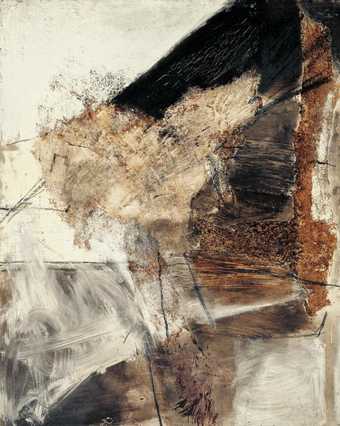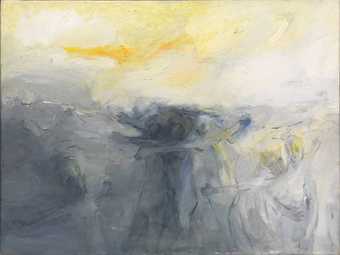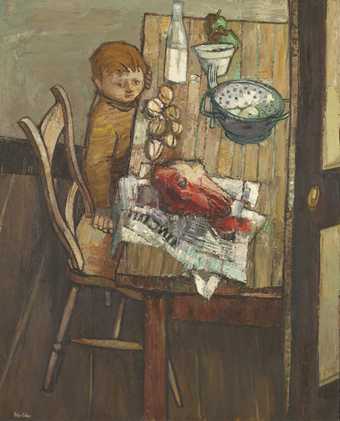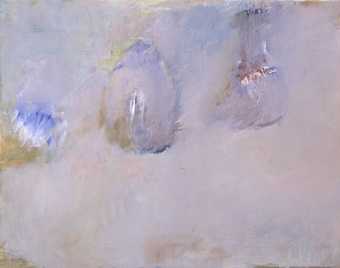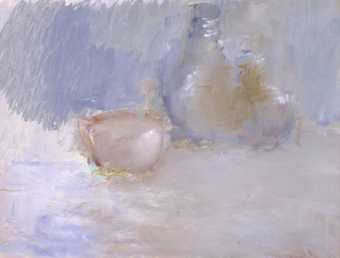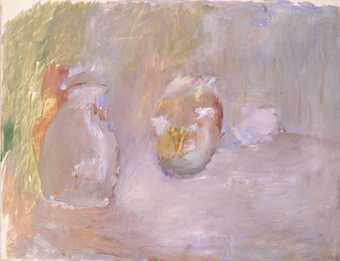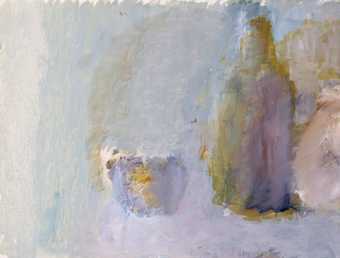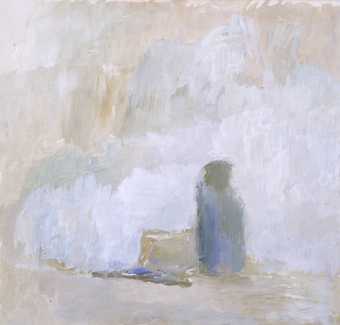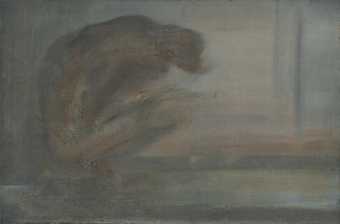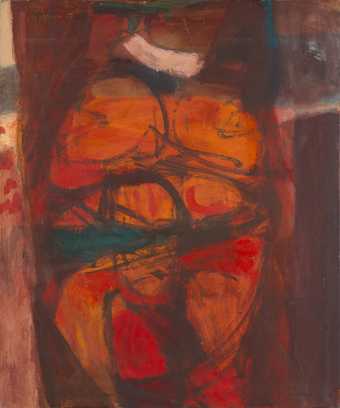
Not on display
- Artist
- Isabel Rawsthorne 1912–1992
- Medium
- Oil paint on canvas
- Dimensions
- Support: 765 × 512 mm
- Collection
- Tate
- Acquisition
- Presented in memory of Warwick Llewellyn Nicholas 2014
- Reference
- T14121
Summary
Baboon and Child c.1964 is an oil painting on canvas by the British artist Isabel Rawsthorne (also known as Isabel Lambert). It depicts a pale female ape in profile, her form echoed by an infant which is enclosed womb-like within the outline of her body. Both animals are in attitudes of embattlement and may be caged. The forms are created by texture as much as by colour and contour, and the thick paint layers form a low relief. The painting can be considered a pair with the contemporaneous Male Baboon c.1964 (Tate T14120).
The compositions of both paintings have their source in drawings that the artist made in London Zoo. She had drawn there from childhood and was elected Zoological Society of London Fellow in 1947. She also made drawings of baboons in Nigeria in 1961. In addition to direct observation of the animals themselves, a number of scientific and artistic sources inspired Rawsthorne. She studied scientific and ethnographic texts such as those of the twentieth-century Austrian zoologist and ornithologist Konrad Lorenz. Rawsthorne was a close associate of the British painter Francis Bacon (1909–1992) who had made studies of apes in the 1950s, which were also based on the studies of animal behaviour of Konrad Lorenz and the American psychologist and primatologist Robert Yerkes (see Jacobi 2009, p.306). In Bacon’s Study of a Baboon 1953 (Museum of Modern Art, New York), the thinly applied and blurred paintwork, through which the background can be seen, suggests both movement and an implicit violence, and the ambiguous placement of the fence allowed the artist to investigate the tension between freedom and incarceration in caged animals. Although Bacon’s and Rawsthorne’s application of paint is very different, the blurring of form to suggest both movement and mood, and the exploration of the dynamic of the cage, express similar concerns. Both Rawsthorne’s and Bacon’s monkey paintings draw on the works of the French sociologist and theorist George Bataille to explore parallels between man and animal, evoking a simultaneous aggression and vulnerability in the human condition that suggests an existential isolation.
As well reflecting her recent experiences in London and Paris, the painting technique that Rawsthorne used in these works has its origins in the artist’s exposure to Nigerian art of the 1960s. She attended the Zaria Art School, Nigeria in 1961, and her adoption of a looser painting technique dates from this period where she studied with Clifford Frith (born 1924) alongside the founders of the Natural Synthesis movement, such as Demas Nwoko (born 1935). The Lion c.1961 (reproduced in Suzanne Doyle, Isabel Rawsthorne 1912–1992 Paintings, Drawings and Designs, exhibition catalogue, Mercer Art Gallery, Harrogate 1997, plate 17, pp.24, 43) demonstrates changes in her technique at this time in its use of heavy impasto to suggest the animal form, which is similar to that used in Male Baboon and Baboon and Child.
Further reading
Carol Jacobi, ‘Cat’s Cradle: Bacon and the Art of “Isabel Rawsthorne”’, Visual Culture in Britain (Special Bacon Issue), vol.10, no.3, 2009, pp.293–314, reproduced p.307.
Carol Jacobi, Out of the Cage: The Art of Isabel Rawsthorne, New Haven and London 2014.
Carol Jacobi and Emma Chambers
October 2013
Does this text contain inaccurate information or language that you feel we should improve or change? We would like to hear from you.
Explore
- emotions, concepts and ideas(16,416)
-
- formal qualities(12,454)
-
- gestural(763)
You might like
-
Sandra Blow Space and Matter
1959 -
Anthony Fry Dance, Blue and Yellow
1960 -
Martin Froy Two Figures Summer ‘61
1961 -
Patrick Hayman Mother and Child near a Town
1952 -
Peter Coker Table and Chair
1955 -
Adrian Stokes Still Life: Last Eleven (No. 4)
1972 -
Adrian Stokes Still Life: Last Eleven (No. 6)
1972 -
Adrian Stokes Still Life: Last Eleven (No. 11)
1972 -
Adrian Stokes Still Life: Last Eleven (No. 5)
1972 -
Adrian Stokes Still Life: Last Eleven (No. 7)
1972 -
Adrian Stokes Still Life: Last Eleven (No. 9)
1972 -
John Craxton Still Life with Cat and Child
1959 -
Isabel Rawsthorne View through a Window II
1967 -
Isabel Rawsthorne Male Baboon
c.1964 -
Albert Irvin OBE RA Enclosed
1963

